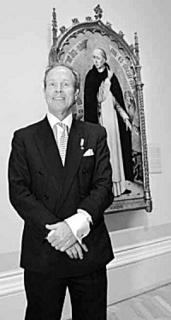Monday, August 08, 2005
 More Googling, this morning, in the matter of Dr. Edmund Pillsbury's curious new association with a Dallas art house, resulted in finding an archived copy of one of the 2003 European news reports mentioned here yesterday on the American Council for Cultural Policy, an April 6, 2003 story in Scotland’s Sunday Herald, and a 2003 Art Forum column referencing the other European news account of the ACCP in an April 2003 edition of Germany’s Süddeutsche Zeitung.
More Googling, this morning, in the matter of Dr. Edmund Pillsbury's curious new association with a Dallas art house, resulted in finding an archived copy of one of the 2003 European news reports mentioned here yesterday on the American Council for Cultural Policy, an April 6, 2003 story in Scotland’s Sunday Herald, and a 2003 Art Forum column referencing the other European news account of the ACCP in an April 2003 edition of Germany’s Süddeutsche Zeitung.According to the Sunday Herald’s Liam McDougall:
It has emerged that a coalition of antiquities collectors and arts lawyers, calling itself the American Council for Cultural Policy (ACCP), met with US defense and state department officials prior to the start of military action [in Iraq]…News of the group's meeting with the government has alarmed scientists and archaeologists who fear the ACCP is working to a hidden agenda that will see the US authorities ease restrictions on the movement of Iraqi artifacts after a coalition victory in Iraq…Among its main members are collectors and lawyers with chequered histories in collecting valuable artifacts, including alleged exhibitions of Nazi loot.
The Art Forum’s summarization of the April 2003 Süddeutsche Zeitung story is the last item in the column and says:
A group of sixty American art dealers, lawyers, researchers, and museum directors formed the American Council for Cultural Policy last year… Their goal is to loosen up the Iraqi antiquities laws under an American-controlled postwar regime.
To guard against imperfect memories and memories colored by incorrect or poorly reported mainstream press accounts of the Iraq Museum looting it is worthwhile to consider this May 2003 web posting on TheNation.com:
The Iraq Museum in Baghdad was one of the three or four most important archeological museums in the world, a treasure house of objects included in every standard art history text book, housing the earliest narrative reliefs and the oldest written works in world history… The looters used professional glass-cutting tools, cranes and trucks over a period of forty-eight hours, as a US tank stood idly outside. At one point a few soldiers strolled into the museum, watched for a while and then left.
A Dallas Morning News account on a Dallas-Fort Worth TV web site from Saturday July 23 reports Dr. Pillsbury’s recent association with a new Dallas employer and quotes the former ACCP member as saying:
"It's [Heritage Galleries and Auctioneers] a dynamic young company that's done very well, particularly in the area of coins and currency and collectibles," Dr. Pillsbury said. "They have convinced me they are serious about developing in the area of fine arts as well, and think I might be of some use in that regard."
As the good doctor surely imagines this new association to be profitable, it might be worth noting that Pillsbury’s previous salary at the Kimball Art Museum in Fort Worth, TX was, according to art investigator Michel vanRijn, over $450,000 per year.
Photo: Nan Coulter

